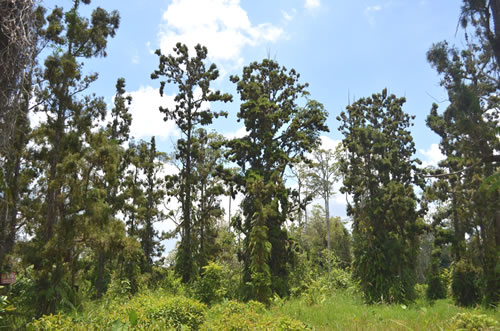
Swamp cypress trees in Dak Lak.
In the 80s, there was a swamp cypress in Ea Ral Commune of Ea Hleo District, Dak Lak Province. To build the irrigation dam of Ea Ral, the forest was chopped down. That time, the value of swamp cypress was not discovered so the rare trees were cut down like normal trees.
In 2009-2010, the fever for swamp cypress appeared. Hundreds of people flocked to Ea Ral to hunt the rare plant. Groundless rumors that swamp cypress can cure cancer and the water-pine collecting hobby of the rich have put this species at risk of extinction. Swamp cypress was hunted by both the bad and the normal guys who wanted to change their lives. Though they tried their best, eight rangers of the Ea Ral ranger station were helpless to protect the rare trees.
In December 2010, when a survey was conducted to establish a project to protect swamp cypress, the project maker - the University of Central Highlands counted only 255 trees in Dak Lak, including 219 trees in Ea Ral (Ea Hleo District,) 31 trees in Trap K'so (Krong Nang district) and 5 trees in Cu Ne (Krong Buk District).
In May 2011, Dak Lak authorities approved the project to conserve swamp cypress in the period of 2010-2015 but it took a year and a half later, until August 2012, the conservation project was kicked off by the launch of the swamp cypress conservation project management board. Consequently, there were only 162 swamp cypress trees at that time, a lost of 93 trees. Five trees of 400-600 years disappeared.
Mr. Tran Xuan Phuoc, Director of the swamp cypress conservation project management board said since the project took over the management of the swamp cypress trees from the local authorities, all trees have been well protected.
In the efforts to conserve the rare trees, Dr. Tran Vinh, Deputy Director of the Institute for Agroforestry Science and Technology has carried out a project to plant swamp cypress in the wild. Accordingly, approximately 1,000 swamp cypress trees will be planted in Dak Lak from June 2013 to 2015.
Swamp cypress is the sole living species in the genus Glyptostrobus. It is native to subtropical southeastern China and in Central Highlands of Vietnam.
The species is nearly extinct in the wild due to over-cutting for its valuable decay-resistant, scented wood and because of its non-regeneration.
Mai Lan